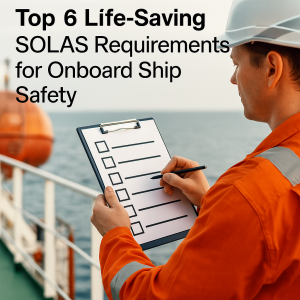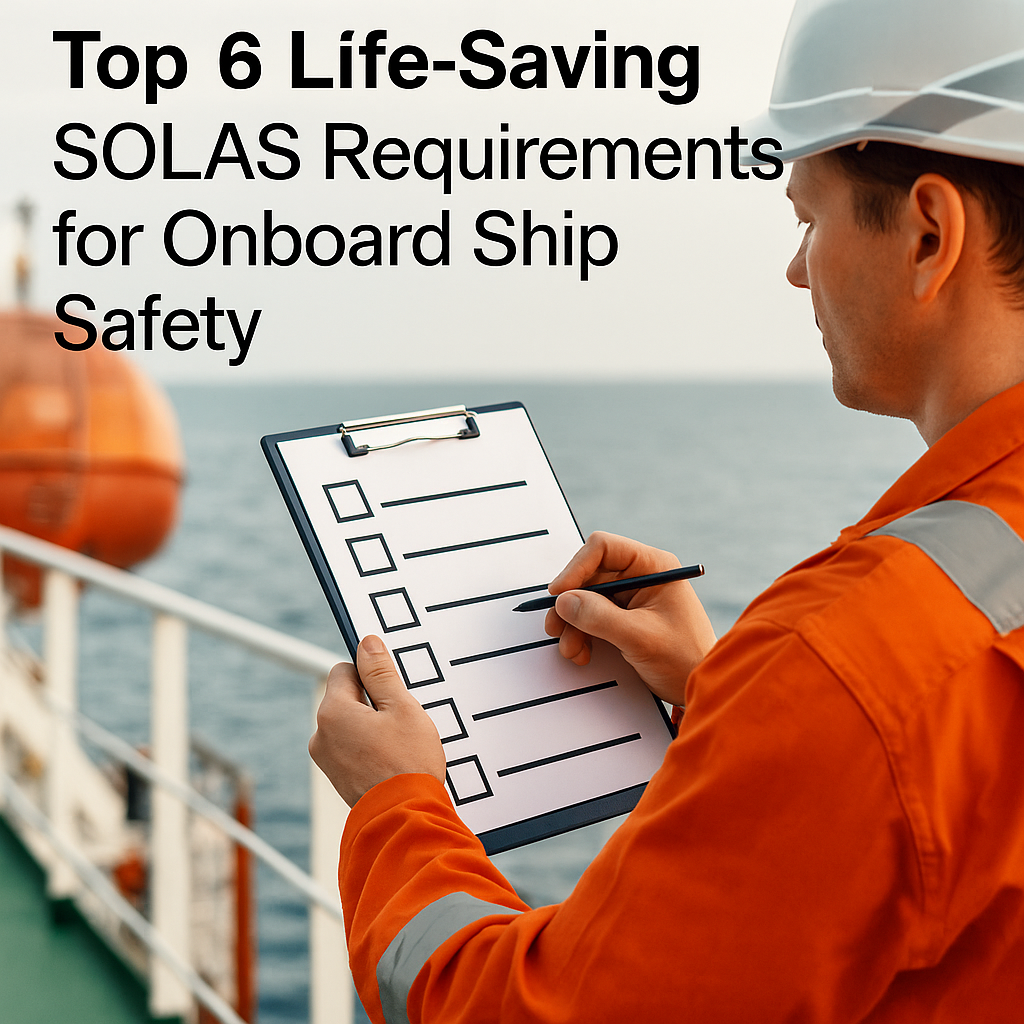Explore the top 6 life-saving SOLAS requirements that protect crew and passengers on modern ships. From lifeboats to fire safety, learn how international rules save lives at sea.

Why SOLAS Still Saves Lives at Sea
In the quiet middle of the ocean, help isn’t minutes away—it’s hours or even days. This is why ships must be ready for emergencies at all times. From onboard fires to abandon-ship scenarios, the difference between tragedy and survival often comes down to safety systems, training, and international regulations.
Enter SOLAS, the International Convention for the Safety of Life at Sea, first adopted in 1914 after the Titanic disaster and continuously updated since. Today, SOLAS is the most important international treaty governing maritime safety. Managed by the International Maritime Organization (IMO), it includes a wide range of technical standards that all signatory countries must enforce on vessels flying their flag.
This article focuses on the Top 6 Life-Saving SOLAS Requirements that every vessel—and every mariner—should know. We’ll break down each requirement, explore real-world cases, and show how these rules keep lives safe on the high seas.
Why SOLAS Requirements Matter in Today’s Maritime Industry
Shipping remains the lifeline of global trade, carrying over 80% of the world’s goods (UNCTAD, 2023). Yet it also faces persistent dangers: rough weather, onboard fires, collisions, grounding, and equipment failures.
SOLAS is not just about compliance; it’s a global safety net. Whether you’re a captain on a 20,000 TEU container ship or a crew member on a small coastal ferry, SOLAS requirements define minimum safety standards that save lives.
Moreover, with new challenges emerging—from cyber threats to climate change impacts—these life-saving provisions are evolving to meet 21st-century risks.
–
1. Lifesaving Appliances and Arrangements (Chapter III)
Mid-summary:
Lifeboats, life rafts, and life jackets are the most recognized symbols of safety at sea—but there’s much more behind their design and deployment.
Key Provisions:
-
Totally enclosed lifeboats with self-righting capabilities.
-
SOLAS requires sufficient capacity to evacuate all persons onboard within 30 minutes.
-
Hydrostatic release units (HRUs) ensure liferafts deploy even if the crew can’t reach them.
-
Lifejackets must support the mouth and nose above water, even if the wearer is unconscious.
-
Monthly testing of launching devices and mandatory abandon ship drills.
Recent Advancements:
Manufacturers like Wärtsilä and Survitec have developed advanced lifeboats with fire-resistant hulls, built-in navigation, and even automatic distress signaling.
Case Example:
In 2021, during a cargo fire aboard MV X-Press Pearl off Sri Lanka, crew were safely evacuated using lifeboats and inflatable life rafts, demonstrating the value of SOLAS-compliant lifesaving appliances.
–
2. Fire Protection, Detection, and Extinction (Chapter II-2)
Mid-summary:
Fires are among the deadliest hazards at sea—especially in enclosed engine rooms, accommodation spaces, and cargo holds.
Key Provisions:
-
Fixed fire suppression systems in engine rooms (e.g., CO₂ flooding systems).
-
Automatic fire detection linked to control panels on the bridge.
-
Fire-resistant construction materials (e.g., bulkheads and ceilings).
-
Fire doors must close automatically during emergencies.
-
Crew training in firefighting and annual drills per IMO Model Course 2.03.
Recent Developments:
Smart fire monitoring systems, like Tyco’s addressable detectors, now offer zone-specific alerts, improving response time. Many vessels now integrate real-time thermal imaging and automated dampers.
Real-World Data:
The Maritime and Coastguard Agency (MCA) reports that electrical fires cause over 30% of onboard fire incidents in UK-flagged vessels. Early detection systems required by SOLAS reduce casualties significantly.
–
3. Emergency Training and Drills (Chapter III and STCW Code)
Mid-summary:
Even the best safety systems mean little if the crew isn’t trained to use them under pressure.
Key Provisions:
-
Mandatory abandon ship drills at least once every month.
-
Fire drills every two weeks for passenger ships, and at least monthly for cargo vessels.
-
STCW-compliant crew must be trained in Personal Survival Techniques, Basic Firefighting, and Crowd Management for passenger ships.
-
Onboard Safety Management Systems (SMS) must document and audit training compliance.
Real-World Practice:
The Harmony of the Seas cruise ship conducts lifeboat drills with RFID-based muster tracking, ensuring every guest and crew member is accounted for.
Recent Update:
As per IMO Circular MSC.1/Circ.1578, drills must avoid risk, especially when lowering lifeboats. This change came after several fatal incidents during drills.
–
4. Emergency Power and Lighting (Chapter II-1)
Mid-summary:
When all lights go out on a ship in distress, the consequences can be catastrophic. That’s why SOLAS requires robust backup systems.
Key Provisions:
-
Emergency generators must provide power for lighting, communication, alarms, and firefighting systems for at least 3 hours.
-
Located outside the main engine room to avoid dual loss.
-
Must activate within 45 seconds of power failure.
-
Illuminates key areas: engine control rooms, fire stations, escape routes, bridge, and lifeboat embarkation points.
Recent Trends:
Ships are increasingly equipped with battery-based emergency systems, offering lower maintenance and faster response times than traditional diesel-powered backups.
Case Example:
During a blackout on MV Ever Forward in 2022, the vessel’s emergency power restored basic operations, avoiding a larger navigational hazard.
–
5. Means of Escape (Chapter II-2, Regulation 13)
Mid-summary:
When seconds matter, the route to safety must be obvious and unobstructed.
Key Provisions:
-
At least two escape routes from every machinery space and accommodation area.
-
Photoluminescent escape route signs must be visible even in smoke.
-
Doors must open in the direction of escape.
-
Escape route lighting powered by the emergency system.
Real-World Concern:
Post-Costa Concordia (2012), escape route requirements were tightened. Some passengers reported confusing signage and blocked corridors, prompting a revision in mustering protocols and escape signage regulations.
Recent Innovation:
Modern vessels use low-level LED strip lighting and interactive signage to guide passengers and crew through smoke-filled areas.
External Source:
IMO Fire Safety Systems Code – Escape Provisions
–
6. Navigation Safety and Bridge Systems (Chapter V)
Mid-summary:
Safe navigation isn’t just about steering—it’s about seeing, planning, and avoiding hazards with full situational awareness.
Key Provisions:
-
Mandatory use of AIS (Automatic Identification Systems) on vessels over 300 GT.
-
ECDIS (Electronic Chart Display and Information System) required for most vessels built after July 2018.
-
Radar systems with ARPA (Automatic Radar Plotting Aids) are standard on SOLAS-compliant vessels.
-
Bridge Navigational Watch Alarm Systems (BNWAS) keep bridge crew alert.
-
Voyage Data Recorders (VDRs) capture critical data for accident investigations.
Emerging Technologies:
Bridge systems now integrate with AI-supported predictive routing, real-time weather overlays, and cyber-secure ECDIS updates.
Case Example:
In 2020, a near-collision between two container vessels in the Malacca Strait was avoided thanks to real-time AIS and radar coordination supported by port VTS.
–
FAQ: SOLAS Life-Saving Requirements – Common Questions
Q1: Are all ships required to comply with SOLAS?
No. SOLAS applies to ships on international voyages over 500 GT, but many coastal or smaller vessels follow similar guidelines voluntarily.
Q2: How often must lifeboats be inspected?
Weekly visual checks and monthly operational tests are required. Full load tests and overhauls occur annually or during drydock periods.
Q3: Is crew training under SOLAS or STCW?
SOLAS defines emergency drills and procedures. STCW governs crew training, certification, and competency, and works in tandem with SOLAS.
Q4: Can ships use non-SOLAS approved equipment?
No. All life-saving appliances, fire detection systems, and emergency gear must be SOLAS-compliant and flag-approved.
Q5: Are lifeboats allowed to have engines?
Yes. SOLAS requires motorized lifeboats capable of moving away from the ship’s side against wind and sea.
Q6: What happens if a ship fails to meet SOLAS standards during a Port State Control inspection?
The vessel can be detained, fined, or denied entry into port until all deficiencies are corrected.
Conclusion: SOLAS as the Lifeline at Sea
When disaster strikes at sea, there’s no second chance. The top six life-saving requirements mandated by SOLAS—from lifeboats to training to emergency lighting—are not optional checklists. They are proven systems, forged through history, disasters, and data, that protect real people in real emergencies.
As technology advances and maritime risks evolve, SOLAS continues to adapt, balancing tradition and innovation to ensure that shipping remains safe, sustainable, and globally coordinated.
References
-
International Maritime Organization. (n.d.). SOLAS Convention Overview
-
MarineTraffic. (n.d.). What is AIS?
-
IMO. (2020). FSS Code: Fire Safety Systems
-
DNV. (2021). Maritime Fire Safety Guide
-
IACS. (2022). Emergency Power Requirements
-
UNCTAD. (2023). Review of Maritime Transport
-
IMO. (n.d.). Model Courses on Emergency Procedures

